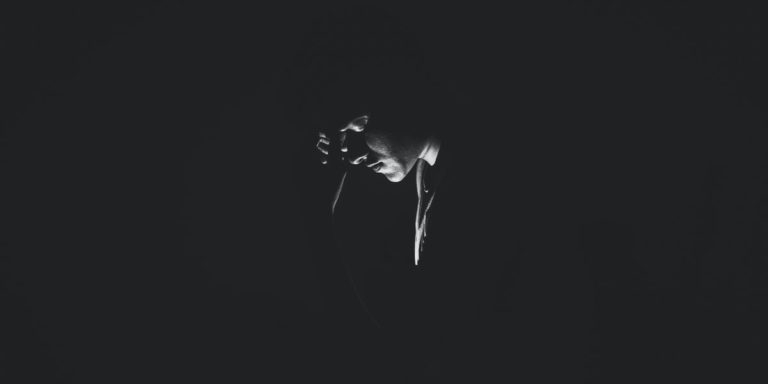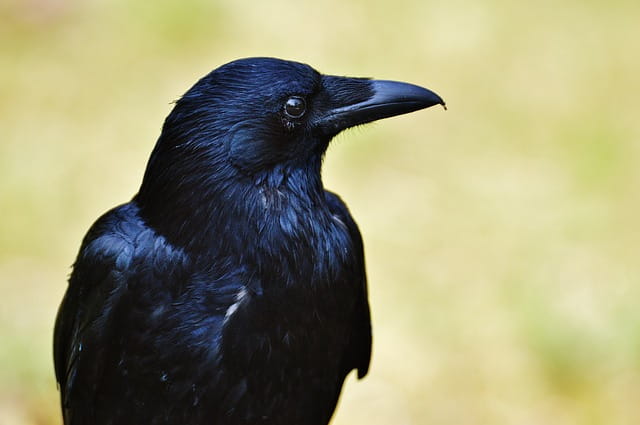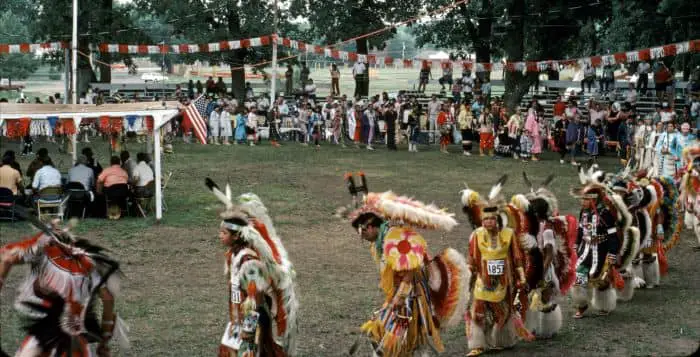Evolution by Sherman Alexie
“Evolution” is written by the famous Native-American poet Sherman Alexie. The poem first appeared in his collection, The Business of Fancydancing: Stories and Poems, in 1992. Alexie is of Spokane and Coeur d’Alene ancestry and depicts the lived experiences of an Indigenous or Native-American individual from a collective perspective through his works.
The poem is an ironic commentary on the systemic obliteration, appropriation, and exploitation of indigenous culture and Indian people. Through the character of the famous real-life American showman and opportunistic soldier, William Frederick Cody, popularly known as Buffalo Bill, Alexie critiques and depicts how Indigenous people have been subject to exploitation, oppression, and violence by white colonists and how their lives are deeply ridden with poverty, alcoholism, and life-long marginalization.
- Read the full text of “Evolution” below:
Evolution by Sherman Alexie Buffalo Bill opens a pawn shop on the reservation right across the border from the liquor store and he stays open 24 hours a day, 7 days a week and the Indians come running in with jewelry television sets, a VCR, a full-length beaded buckskin outfit it took Inez Muse 12 years to finish. Buffalo Bill takes everything the Indians have to offer, keeps it all catalogued and filed in a storage room. The Indians pawn their hands, saving the thumbs for last, they pawn their skeletons, falling endlessly from the skin and when the last Indian has pawned everything but his heart, Buffalo Bill takes that for twenty bucks closes up the pawn shop, paints a new sign over the old calls his venture THE MUSEUM OF NATIVE AMERICAN CULTURES charges the Indians five bucks a head to enter. - from The Business of Fancydancing: Stories and Poems (1992)
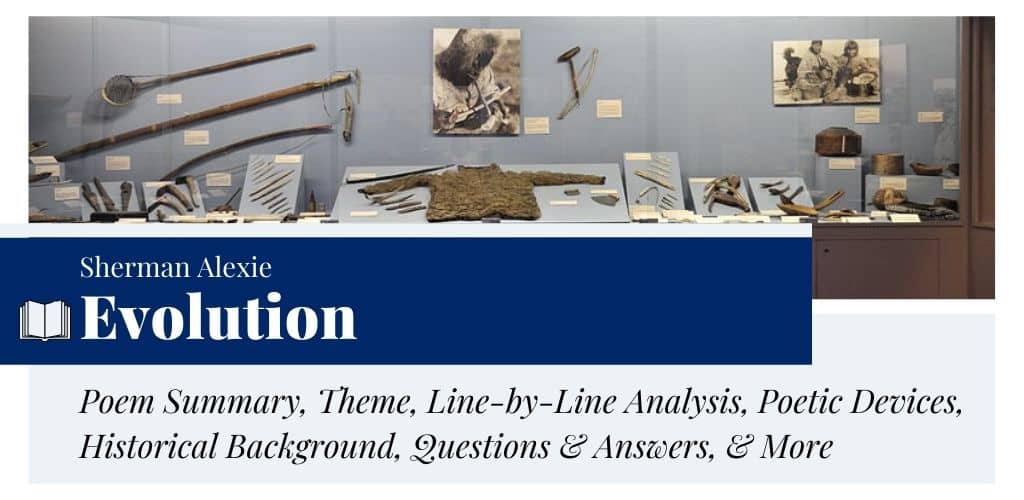
Summary
In the poem “Evolution,” Sherman Alexie talks about how white Americans exploit Native-American people and their cultures. Though the central character appears to be Buffalo Bill, he is the antagonist who represents “white” settlers and symbolizes a cultural erasure of Indigenous communities. He opens a pawn shop in an Indian reservation (areas designated for federally-recognized Indigenous tribes to live, while their own native lands were forcibly/deceptively taken away by white colonialists) where he offers loans to Native Americans in exchange for various “goods” that they bring to pawn.
However, the system is highly exploitative, and Bill wants to trick the native people – he collects whatever they bring in and offers them measly prices for their belongings. They keep pawning their valuables, including a “beaded-buckskin outfit” that took one “Inez Muse” twelve long years to make.
In the end, Bill takes everything the people own and opens up “THE MUSEUM OF NATIVE AMERICAN CULTURES,” in an ironic twist. The darkly humorous ending depicts the extent to which white oppressors would go in order to advance their own selfish gains and harm native individuals – Bill now charges Native Americans five dollars per head to enter the museum, which ironically comprises of items belonging to them in the first place.
Meaning
In “Evolution,” Alexie points out the dark and grim realities of the lives of Native-American people, who have to constantly suffer at the hands of exploitative white oppressors while also battling issues such as alcoholism, gambling, and poverty in their respective reservations. While Buffalo Bill’s motives in opening a pawn shop seem neutral at first glance, it quickly becomes apparent that his sole purpose is to exploit the indigenous individuals for his personal gain. The very fact that the shop is across from a “liquor store” and he stays open 24/7 is proof enough of his manipulative, selfish tendencies. Buffalo Bill keeps exploiting the natives and taking their items until they come to sell even their bones and body parts. This depicts the height of exploitation by oppressors.
“Evolution” is a commentary on years of systemic oppression and cultural appropriation that white people meted out to Native people. The fact that Bill continues taking everything he can get his hands on of the Indigenous people and pays a pittance for them shows that his sole aim is to selfishly gain and plunder as much as possible – which is an extended metaphor for white settlers’ atrocities and plundering of Native people.
The ending is extremely dark and ironic – the very person who is responsible for the poverty and marginalization of native people is the one who now opens up a museum in their name and portrays himself as the protector and promoter of “Native American cultures.” A more profound irony is that the cultures of native individuals have been commodified, and they are so separate and lost so much that these individuals have to pay money to see their own cultural remnants put on display in a gross exhibitionistic fashion.
Form, Rhyme Scheme, & Meter
Form
“Evolution” is a short narrative poem that comprises five tercets made up of three lines each. The poem is a modern one; however, Alexie deliberately deviates from the notions of rigid versification and structure. The lines are of unequal length, and the content of stanzas blur into each other. There is no rigid boundary that separates one stanza from the next; this heightens the suspense and the storytelling employed by Alexie in this poem. The poem is written in the third-person point of view; the speaker is a distant yet omniscient narrator who gives an account of the happenings in the Indian reservation where Buffalo Bill tries his hand.
Rhyme Scheme
The poem is written entirely in free verse, and hence it discards a formal rhyme scheme. Alexie is a contemporary poet, and he incorporates modernist conventions like writing free-flowing poetry without boundaries rather than following rigid rules. As aforementioned, the trajectory of the poem and the story it communicates becomes central; therefore, versification and rhyming patterns are not focused upon much. Yet, there are a number of internal rhymings that maintain the flow while reading.
Meter
The poem does not follow a strict metrical pattern; it is more dynamic and organic since it is a postmodern poem. The lines are of unequal length, and the focus is more on the poem communicating a story rather than metrical structure. The absence of a rhyming pattern is substituted by endless run-on lines that merge one line with the next. Alexie depicts the events of Indigenous lives in a way that is not bogged down by rules and conventions laid down for writing poetry. The omission of capitalization throughout the poem and doing away with rigid punctuation are some of the poetic licenses Alexie uses to write the story of his own people.
Poetic Devices & Figurative Language
Irony
This is one of the essential poetic devices that Alexie uses in “Evolution.” The ending of the poem depicts this device, where Buffalo Bill, the person who exploits the Native-Americans of their possessions through addiction, opens up a “Museum” displaying “Native American Cultures,” and even charges the real owners to look at their lost possessions:
closes up the pawn shop, paints a new sign over the old
calls his venture THE MUSEUM OF NATIVE AMERICAN CULTURES
charges the Indians five bucks a head to enter.
Alliteration
This poetic device is used in various places throughout the poem, especially through the central character of “Buffalo Bill” in lines 1, 6, and 12. Apart from that, it occurs in the following instances:
- “reservation/ right” (lines 2-3)
- “beaded buckskin” (line 5)
- “it took Inez” (line 6)
- “12 (twelve) years to” (line 6)
- “falling endlessly from” (line 10)
- “his heart” (line 12)
- “pawn shop, paints” (line 13)
- “over the old” (line 13)
Repetition
The repetition of “pawn” can be seen through the following lines, which is meant for the sake of emphasizing the idea of pawing one’s own identity in exchange for money:
pawn their hands, saving the thumbs for last, they pawn
their skeletons, falling endlessly from the skin
and when the last Indian has pawned everything
Enjambment
There are many run-on lines that enhance the flow and story-like feel of the poem. For instance, Alexie uses enjambment right from the second tercet:
and the Indians come running in with jewelry
television sets, a VCR, a full-length beaded buckskin outfit
it took Inez Muse 12 years to finish. Buffalo Bill
takes everything the Indians have to offer, keeps it
all catalogued and filed in a storage room. The Indians
pawn their hands, saving the thumbs for last, they pawn …
Symbolism
This can be seen in the following lines:
all catalogued and filed in a storage room. The Indians
pawn their hands, saving the thumbs for last, they pawn
their skeletons, falling endlessly from the skin
and when the last Indian has pawned everything
but his heart, Buffalo Bill takes that for twenty bucks
Here, the image of “hands” and “skeletons” is symbolic of the life, work, and soul of Indigenous people. They give away their life’s possessions and cultural items to Buffalo Bill in exchange for money. Furthermore, the “heart” is a symbol of indigenous identity.
Line-by-Line Analysis and Explanation
Lines 1-3
Buffalo Bill opens a pawn shop on the reservation
right across the border from the liquor store
and he stays open 24 hours a day, 7 days a week
In the first three lines of “Evolution,” the exposition is introduced. The poem moves very sequentially, with a beginning, middle, and an ironic end. Right from the first few lines, Alexie communicates the historical and cultural context of the poem. It is very deliberately depicted that Buffalo Bill has opened up a pawn shop across the “liquor store.” This says how manipulative and cunning his intentions are – he knows that this will ensure people keep coming to his shop whenever they want to keep drinking.
His cunningness is also highlighted through the line, “and he stays open 24 hours a day, 7 days a week.” Bill’s mind is tuned only to one thing – to extract the maximum possible benefit from his “venture” and translate it to monetary means. Alexie highlights two crucial problems of Native American reservations here – alcoholism and gambling. The problem of poverty and deprivation also emerges strongly throughout the poem.
Lines 4-6
and the Indians come running in with jewelry
television sets, a VCR, a full-length beaded buckskin outfit
it took Inez Muse 12 years to finish. Buffalo Bill
In these lines, the omniscient, critical speaker points out how Bill’s tactics are increasingly successful – the indigenous people bring various things to pawn in his shop pretty hurriedly: “the Indians come running in …” These lines highlight the various things brought to the shop by the native people.
The “beaded buckskin outfit” becomes important; an Indigenous person is selling something that one of their people, “Inez Muse,” painstakingly wove for twelve years. It is a harsh depiction of the extent to which addictions have pervaded Native Americans. It also highlights the root cause of this problem to be systems laid down by white policymakers.
It is also important to note the commodification of Native culture indicated in this stanza. Buffalo Bill collects all these items and pays measly pittances for them. He treats every object that the Indigenous people bring as the same. He does not value or respect the living specimens of Native cultures; his only intention is to make money from the Indigenous people and appropriate their cultures. The fact that a piece of Native American culture like the “beaded buckskin outfit” is being treated as trivial is an instance of historical obliteration of Indigenous cultures.
While Bill does not treat the precious item as anything important and stores it like any other object he has, he then proceeds to display it in the museum at the end and profits from it. This shows that he knows the actual worth of the items he is acquiring from the native people; however, he wants to exploit them and reap all the benefits for himself without acknowledging the rightful origins and ownership of their culture.
Lines 7-9
takes everything the Indians have to offer, keeps it
all catalogued and filed in a storage room. The Indians
pawn their hands, saving the thumbs for last, they pawn
The third stanza of “Evolution” advances the oppression and exploitation meted out to Indigenous people by Buffalo Bill. The line “all catalogued and filed in a storage room” highlights the commodification and objectification of native cultures. Bill does not care about the sufferings and desperation of the indigenous people, and instead, he continues to monetize their culture. It is excruciating and disturbing for the speaker to describe the white colonial idea of profit and self-gain.
The ninth line shows the extent of desperation and poverty that native people are undergoing. This also throws light on the violence that white oppressors inflicted upon Native communities. The reference to the real Buffalo Bill also becomes significant. William Frederick Cody or Buffalo Bill was a US Army scout who was at the forefront of suppressing indigenous rebellions in the West against white settlers.
Bill violently suppressed many Native Americans while serving in the army, and his show, Buffalo Bill’s Wild West, was “famous” for portraying the “savagery and adventure” of the West. He depicted Indigenous cultures and people in a very offensive, stereotypical light and profited off their painful stories by glorifying the white “civilizing” mission.
This is precisely what Alexie tries to allegorically portrays in his poem “Evolution.” The modern “Buffalo Bill” in this poem goes on stocking up on the life and blood of the native people, who pawn all their belongings to him. His sole purpose is to mooch off on their situation and extract material gains from centuries of cultural history.
Lines 10-12
their skeletons, falling endlessly from the skin
and when the last Indian has pawned everything
but his heart, Buffalo Bill takes that for twenty bucks
The fourth tercet marks the climax for the poem and the story it portrays; Alexie uses dark humor (or barbed sarcasm) to highlight the extent of ruthlessness and brutality of white oppressors, which has now reached its peak. The highly visual descriptions in this stanza enhance the misery of indigenous people. For instance, the line, “They pawn their skeletons, falling endlessly from the skin,” is highly graphic and horrific.
The idea that the native people have now resorted to selling away parts of their bodies (an extended metaphor for pawning one’s life and soul) depicts the gruesome physical oppression they are subjected to. Buffalo Bill does not hesitate to squeeze every last inkling of money from the Native people and then some more.
The final line of this tercet is the height of inhumane cruelty; for Bill, a human heart’s value is measly twenty dollars! Through this line, Alexie portrays the social position of Native Americans in white America. Through this grim image, he points out how colonialists would go to any lengths to subjugate indigenous people and their culture if it brings them personal gain. They would plunder native people until they could not “give” them anything more. In this way, Alexie talks about the unthinkable dehumanization and exploitation that have become everyday realities for Native Americans.
Lines 13-15
closes up the pawn shop, paints a new sign over the old
calls his venture THE MUSEUM OF NATIVE AMERICAN CULTURES
charges the Indians five bucks a head to enter.
In the last stanza of “Evolution,” Alexie uses his characteristic irony and dark satire even more to depict the plight of indigenous people. Buffalo Bill, the representative of white colonial oppression, embodies the ideals of profit and materialism even further than the previous stanzas. Just when it appears as if he can no longer extract anything else from the individuals living on the Indian reservation, he opens up a museum displaying their “lost” tradition.
Buffalo Bill closes up the “pawn shop” because there is no possible way that he would be able to gain anything more from the Indian reservation. They have pawned everything down to their skeletons. Therefore, he now conjures up a way to transfer his “earnings” from them so far into another “asset.”
The name of the establishment, “THE MUSEUM OF NATIVE AMERICAN CULTURES,” is filled with irony. The fact Bill paints a new sign over the old and establishes this “MUSEUM” in the same place his pawnshop was, heightens the idea that this venture is based upon exploitation and tyranny. While Bill appears to be a “savior” of Native American cultures to outsiders who visit the museum, they have no idea of the origin or “evolution” of the establishment. The history of pain, marginalization, and oppression gets erased and whitewashed through this venture.
The colonial appropriation of indigenous cultures goes one step further when Alexie ironically depicts that Buffalo Bill will now charge the Native Americans to enter the museum and look at things they themselves pawned on display for the world to see. The pain and misery are only heightened when the previous stanzas are considered in unity with the last stanza. Not only are the material things of the Native Americans on display; they have given away pieces of themselves, their culture, and their identity only to have it humiliatingly put on a show by another capitalist, Buffalo Bill.
One Step Deeper: An Alternative Interpretation
It is also essential to consider a deeper interpretation of the last line of the poem. Buffalo Bill opens this “museum” in the same place as the pawnshop – in the reservation. Reservations were sort of “allotted” spaces for Native Americans to live in, which was itself based on the ideas of exclusion and curbing their freedom. This meant that a reservation was vastly comprised only of Indigenous people. It suggests that most visitors to the “museum” would be the Native people from the reservation, which only enhances the irony of the poem. They have to pay five dollars each to see their own culture appropriated, misrepresented, and stolen from them by the settlers in the “THE MUSEUM OF NATIVE AMERICAN CULTURES.”
Theme
Obliteration and Appropriation of Indigenous American Cultures
This emerges as the most important theme in Sherman Alexie’s “Evolution.” Alexie depicts the oppression of indigenous Americans and the cultural appropriation that white Americans inflict upon them throughout the poem. Buffalo Bill encroaches upon the already meager reservation “allotted” to indigenous people. He does it with the purpose of exploitation, is very telling of the colonial idea of superiority/hegemony over every other culture and the mass destruction they undertook to erase indigenous identities systemically.
Buffalo Bill sets up his store right across the liquor store, encouraging indigenous peoples to sell more of their items to drink more. Bill, therefore, represents systems that encouraged continued poverty and addiction in Indian reservations.
Towards the end, we can see that the native people become, more or less, puppets in the hands of Buffalo Bill. They fall into the trap and are forced to sell everything they own; Alexie even describes how they sell their skeletons and organs. This shows the extent to which white Americans oppress indigenous people and how they do not even hesitate to stoop to unfathomable lengths to advance their own interests.
This idea gets exemplified in the ending even more; when Buffalo Bill shuts down the “pawn shop” after he has squeezed everything he can from the people, and then ironically opens up “THE MUSEUM OF NATIVE AMERICAN CULTURES,” displaying all the collected items (from exploitation) for profit. This blatant cultural appropriation only gets more hard-hitting when Alexie writes that Bill will now charge the native Americans to see this very humiliating exhibition.
The fact that Buffalo Bill builds this “Museum” through exploitation and erasure is what the title justifies. The “de-evolution” displayed by Buffalo Bill’s museum omits the systemic violence and deception to gain the items which are now on display. Rather than being a depiction of Native American cultures, the “museum” symbolizes the whitewashing and appropriation of indigenous cultures.
Historical Background
Sherman Alexie is an Indigenous American writer and poet who belongs to the Spokane-Coeur d’Alene Native American nation. He grew up on a Spokane Indian reservation in Washington. He experienced first-hand issues and harsh realities of indigenous people living in reservations (which was a systemic attempt at taking away indigenous lands and limiting them in clusters to fixed “cultural pockets” so that they could be “civilized”/governed more easily). White oppression on indigenous communities ranges from systemic violence and mass murders, erasure of ethnic identities and cultures, stealing native lands and forced removal of native people, cultural appropriation, and is the cause of their poverty and degradation.
Alexie is very vocal about these inequalities and oppression, and in his works, he talks about his experiences of being an indigenous individual in racially-conscious America. He also focuses on the issues and difficulties of people who live in Indian reservations; gambling, alcoholism, and addiction are daily realities they have to face, along with extreme poverty and marginalization. Alexie himself battled alcoholism in his late teenage years and later came out of his addiction after the publication of his first book in 1992, I Would Steal Horses. The same year, he published his first poetry collection, The Business of Fancydancing: Stories and Poems. Therefore, his works are highly autobiographical and portray his genuine experiences.
Buffalo Bill: An Icon of the “Civilizing” Mission
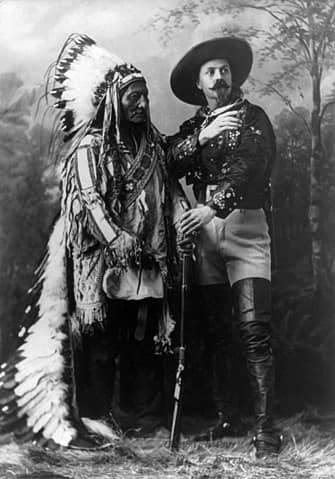
From The Business of Fancydancing (1992), “Evolution” contains a character named Buffalo Bill, who becomes very important to the contextual background of the poem. Buffalo Bill (real name, William Frederick Cody) was a US Army scout, hunter, and performer/showman. He was central to the government’s attempts to subdue indigenous rebellions, and he himself was responsible for many violent episodes inflicted upon Native Americans. He killed many and even publicly “scalped” an indigenous warrior known as Yellow Hair, who belonged to the Cheyenne tribe.
Along with these brutal atrocities, he also became internationally known due to his showmanship. His touring show called Buffalo Bill’s Wild West became highly sensational to its depiction of the “wild,” cowboy-Esque, adventurous life in the “uncivilized” West. However, this show depicted indigenous people in a whitewashed, stereotypical light where they were portrayed as “savage aggressors” who attacked white colonialists in their mission of civilizing them. Alexie’s use of Buffalo Bill as representative of white oppression on indigenous people and culture becomes pertinent in the context of “Evolution.”
Questions and Answers
Sherman Alexie’s “Evolution” is about a venture capitalist, Buffalo Bill, who opens a pawnshop in an Indian reservation near a liquor store. Due to their poverty, the Indians pawn everything they own in order to sustain their family, while some pawn their valuables to buy liquor from across the border store. After accumulating everything, Bill revamps his pawnshop and builds a museum displaying the items he gained from a cheap bargain. Now, he charges an entry fee of five bucks from the Indians to just enter the museum.
Sherman Alexie uses the title “Evolution” to heighten the irony of the poem and speak of the history of oppression and cultural appropriation that indigenous people have to suffer. Buffalo Bill sets up “THE MUSEUM OF NATIVE AMERICAN CULTURES” comprising of the things he obtained from the indigenous people in the reservation itself. The title plays on the idea of the “evolution” and origin of the museum – people are rarely aware of the cultural appropriation and history of marginalization behind the things displayed in museums.
Alexie tries to point out how the things that are oft-glorified and marveled at usually have a painful history and an evolutionary plot. A person who visits Buffalo Bill’s museum will only marvel at the exhibition of Native American cultures. Still, they will never understand the whitewashed narrative and injustice that the people of those cultures have undergone, only to have themselves humiliatingly misrepresented. Thus, Alexie focuses on the “devolution” of indigenous cultures, with the ironical story of the museum’s “evolution.”
In this poem, Alexie hints at the appropriation and exploitation of indigenous people through the story of Buffalo Bill. The “evolution” of Buffalo Bill from a pawnbroker to a museum owner is portrayed through this poem.
The poem signifies how the white settlers actually traded with the indigenous American people. In order to emancipate them from their condition, they made the indigenous people trade their valuables and, most importantly, their identity in return for a place (reservation) to live safely.
In 1987, Sherman Alexie took up creative writing and became acquainted with Chinese-American poet Alex Kuo, who inspired Alexie to write poetry. Later, he started writing and published the first book of poetry, The Business of Fancydancing: Stories and Poems,in 1992. The poem “Evolution” appears in this collection.
The central theme of “Evolution” is the exploitation, obliteration, and appropriation of Native American cultures at the hand of the white settlers beginning from the 17th-century and later at the hands of the American government.
The speaker of “Evolution” tells the story of Buffalo Bill in a satiric tone. He mockingly describes how the Indians of the reservation lost their belongings, cultural artifacts, and even their identity to a mere pawnbroker. Later, when he opens up a museum, it not only displays an “exotic” culture but the “disease” that is eating the indigenous cultures from within.
The “pawn shop” of Buffalo Bill symbolizes a means to appropriate and obliterate the indigenous cultures. Through this shop, Alexie portrays how the Indians are ready to even trade their identity for measly “twenty bucks”!
The irony of the poem lies in the last stanza of the poem. It begins with the line, “when the last Indian has pawned everything/ but his heart, Buffalo Bill takes that for twenty bucks.” Alexie describes how the Indian trades his roots for twenty dollars. The irony is stretched further with the all-capital hoarding of the museum, “THE MUSEUM OF NATIVE AMERICAN CULTURES.” Lastly, the irony hits right at the core with the fact that now Indians have to “pay” to see what they have “pawned.”
Buffalo Bill is the central character of Alexie’s poem “Evolution,” who exploits and takes advantage of the indigenous people from the reservation to advance his own business. His character references the real-life American William F. Cody or Buffalo Bill, who was a U.S. Army scout and showman. He is infamous for having brutally massacred many indigenous warriors and suppressing rebellions. His show, Buffalo Bill’s Wild West, depicted the “savagery and adventure” of the West; showing Native Americans in a stereotypical light and trivializing their sufferings and oppression at the hands of white settlers.
Sherman Alexie is an indigenous writer who belongs to the Spokane-Coeur d’Alene Native American nation. In his works, he speaks about the lived experiences of Native American people and depicts the difficulties of life in Indian reservations riddled with alcoholism, poverty, and discrimination. He draws on his own experiences as an indigenous individual to highlight the oppression of Native Americans by white settlers.
Similar Poems
- “Crow Testament” by Sherman Alexie — This symbolic poem depicts the suffering of Native Americans through the story of a symbolic “Crow.”
- “The Powwow at the End of the World” by Sherman Alexie — It’s about an enraged indigenous individual who thinks of avenging the attack on their traditions and cultures.
- “Indian Boarding School: The Runaways” by Louise Erdrich — It’s about the life, suffering, and humiliation of indigenous children and youth admitted to Native American boarding schools.
- “The animals in that country” by Margaret Atwood — This poem sheds light on the history of Canada from the perspective of an indigenous inhabitant.
External Resources
- Check out The Business of Fancydancing: Stories and Poems (1992) — Explore other poems from Alexie’s first poetry collection that is based upon the “hard realities” of Native Americans.
- About Buffalo Bill — Read about the life of Buffalo Bill Alexie alludes to in “Evolution.”
- Life on Native American Reservations — Learn how Indigenous peoples experience unequal life conditions within the 326 Native American reservations.
- Adulteration of Native American Cultures — Explore how Native American cultures have been appropriated in the name of profit.
- About Sherman Alexie — Learn about the likings of poet Sherman Alexie and explore more about him on his official website.
- Poet Profile & Poetry of Sherman Alexie — Read more about the poet and his works.

